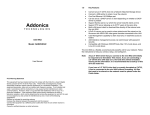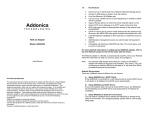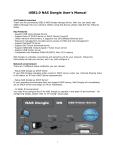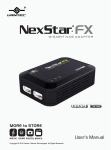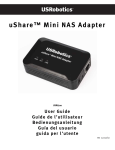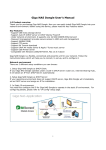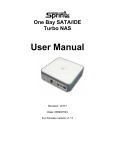Download Addonics Technologies NASU2 User manual
Transcript
1.0 Key Features • • • Addonics T E C H N O L O G I E S • • • • • • NAS Adapter Model: NASU2 • • • • • User Manual The NAS adapter is a flexible, economical and powerful unit for your Network. Follow the instructions to help you connect, setup, and configure it. Note: FCC Warning Statement This equipment has been tested and found to comply with the limits for a class B digital device pursuant to Part 15 of the FCC rules. These limits are designed to provide reasonable protection against harmful interference in a residential installation. This equipment generates, uses and can radiate radio frequency energy. If not installed and used in accordance with the instructions, it may cause har mful interference to radio communications. However, there is no guarantee that interference will not occur in a particular installation. If the equipment does cause harmful interference to radio or television reception, which can be determined by turning the equipment on and off, the user is encouraged to try and correct the interference by one or more of the following suggestions. Reorient or relocate the receiving antenna Increase the distance between the equipment and the receiver Connect the equipment to a different power outlet other than the one where receiver is connected Consult a certified television or radio technician Convert any USB 2.0 / 1.1 mass storage device into a Network Attached Storage device Great for adding Addonics Storage Tower, Storage Rack or any Addonics USB storage device onto the network USB port can be use to power most 2.5" USB hard drive or any low power USB devices Connect a USB printer to share it over the network One Fast Ethernet 10/100Mbps port Can be set as a DHCP server or client depending on whether a DHCP server is present Support Samba server, by which the server hosts 64 clients on line Support FTP server allowing up to 8 FTP users at the same time Built-in Bit torrent client to download files directly off the internet onto the attached USB storage device UPnP AV server can be used to share photo/music files stored on the file server with XBOX 360 video game consoles connected to the LAN Supports USB 2.0 / 1.1 specification. User Management capability to allow read only or read/write access to folders Administrative management access via web browser with password security. Compatible with Windows 2000/XP/Vista, Mac 10.5.4 and above, and Linux 2.6.x and above Any external USB storage device that you connect to the NAS adapter must be first initialized and formatted. This means that if you are connecting an external USB drive with data on it, you will need to make a backup of this data and transfer them back to the USB drive after the drive finishes the formatting by the NAS adapter. Network Environment There are 3 different setup conditions you can choose: Note: “SDisk utility” was written with JAVA script, please make sure your computer has installed JAVA before, if not please install the JAVA script form the CD drive. A. Setup NAS Adapter as a DHCP Client: If your NAS adapter is connected to a LAN network with an active DHCP server, it will obtain an IP address from DHCP server automatically. B. Setup NAS Adapter as DHCP Server: If your LAN network does not have an active DHCP server, NAS adapter will immediately act as DHCP server and assign itself an IP address for installation. 2. When NAS Adapter has been found, click “Connect” to enter configurations. C. Setup NAS Adapter in Static IP environment: You need first configure the IP address for NAS adapter to operate in the static IP environment. For Configuring details, please refer to “IP Config” setup page. 2.0 NAS Adapter Hardware Installation Connections: 1. Connect external USB Storage device into USB port of the NAS Adapter. Power on the USB Storage device. 2. Connect LAN cable via LAN switch and Router. 3. Connect 5V power adapter to power up the NAS adapter NAS Adapter connected directly to a computer’s NIC card If you connect the NAS adapter to a computer directly, the adapter will act as a DHCP server, assigning itself an IP address automatically and also will assign an IP address to the computer’s network card. NAS Adapter connected to a Router or Switch If your NAS adapter is connected to a LAN network with an active DHCP server, it will obtain an IP address from DHCP server automatically. Or if your LAN network does not have an active DHCP server, NAS adapter will immediately act as DHCP server and assign itself an IP address for installation 3.0 1. Search NAS Adapter by SDisk Utility Browse the CD enclosed in the product package. Copy and paste “SDisk Utility” in to your computer then double click the icon to start search. Open NAS Adapter web GUI by using web browser. 1. Open web browser and type default host name “storage” in the search bar. 2. Default login is “admin” for both User name and password. Click “OK” to enter configurations. Status Provide the basic information for NAS Adapter. Identification You can change and modify your host, group name and password from this page. Click “Apply” to save the setting. Host name: This is used to identify your device on the network. If you prefer a different name, type in the new name and click “Apply” to save setting. Group Name: This should be the same as your workgroup. In general, the default “WORKGROUP” will be OK. But if your workstation belongs to different workgroup, type in the correct group name to modify. For Window OS, right click on “My computer” and choose “Properties”, go to the computer name tab to see your current workgroup. If using a Mac OS system, to join a Windows workgroup, open the directory access utility (under Applications-> utilities). Select SMB and click configure to modify the settings (administrator access required to access this option.) Note: We strongly suggest you to change the password as soon as you logged in, to prevent unauthorized access. Date/ Time Setting You can change time setting from this page. Clicks “Apply” to save the setting. By default SNTP is set to Network Time Service otherwise select synchronize to PC. If internet access is available, we recommended setting SNTP to Network Time Service instead. IP Configuration By default, “IP Config” is set to “Automatic IP”. This will allow the NAS adapter to obtain its IP address automatically. If you prefer setting it manually, select the static IP option, enter your own value and click “Apply” to confirm the new setting. Maintenance This page allows you to update the NAS adapter firmware, to go back to factory default settings or reboot NAS system. Disk Utility In this page, you can manage hard disk settings of the USB storage device. Format: For first time installation, you need to format hard disk into FAT32 file system. Formatting the drive will erase all data on the hard drive. Warning: For hard drives with data on it, be fore you have a backup before proceeding to format the hard drive! Tip: You can transfer back the backup data to the NAS Public folder for sharing via the network or USB connection of the USB Storage device. Sleep Time: This is to select hard disk sleeping mode. Scan Disk: After the scan, it will show file content information and health status for the hard disk. Firmware update: Follow the steps below to update the loader and firmware for NAS adapter. 1. Download the latest firmware. 2. Store the firmware file on your computer and decompress them if necessary. 3. Browse your system and locate the firmware (BIN file). 4. Click on “Upload”. 5. Confirm the pop-up massage to start the update. 6. Wait and DO NOT click anywhere else or turn off the power. The upgrade might take a few minutes. 7. Once the update is done, it will prompt you to reboot the device. 8. Click on ”reboot” to restart the device. 9. Wait for about one minute and then go to the status page to confirm the update was successful. Factory defaults: If you experience problems after a firmware update, it is recommended to reset all settings. Note: Resetting the device will remove all folder from the sharing list, erase the FTP accounts, and reset all other settings! Please do not power off or disconnect NAS adapter connection during the firmware update process. System reboot: This can be used to restart the network drive after a firmware update. Click “Modify” to share a folder. Select “User1” from Folder List and click the “à” to add user on “Sharing List”. SMB Server SMB server allows you to share data or files through the network LAN. When a USB storage device is connected, a default Public folder is available to be shared among Guest users. A default Guest user is also created. Note: Only use English alphabet for folder names and no special characters when creating new folders. How to create a user Click on the “Add” button and type new account name and password. Click “OK”. The NAS adapter will also create a SAMBA folder named “User1”. To Access the folder From the Windows start button, type “Run”, and type \\ follow by the IP address. Eg:\\192.168.1.121 and click OK to continue. Type “User1” and password to login. Enter new password then click “Apply” to save setting. Now you have set up the folder that you wish to share on your NAS adapter. This folder can be access from other computer on your local network. How to modify account password Select “User1” and then click “Modify”. How to delete a SAMBA account Select an account you wish to delete. Click “Delete” to proceed. Please note that all the data inside the folder will be lost after the delete. FTP Server Remember to “Enable” the FTP service on the status page, when you plan on using the FTP server. FTP server Configuration: The standard port for FTP service is 21. If required, you can change it from any port between 1025-65500. But in general, we recommended using the default port of 21. File language support: By default, the encoding is set to English. If you want to store or transfer files with a different encoding (different language), choose the corresponding language for the drop down list. In order to transfer and view the files correctly, it is important that you select the correct language! Anonymous: By default an anonymous user name has been created, it allows FTP users to login without username and password. For security reasons, it is best to add a password! Note: To be able share FTP resource you need a router to assign the IP address. Enter a name and password for the new FTP account and click “Next” to continue. In the account list, you can see an overview of the existing accounts and status. Click “Apply”. For FTP file transfers, we recommend to use other dedicated FTP client software e.g.: SyncQuick FTP, Cute FTP etc. Note: When creating FTP accounts, please use only English alphabet and no special character or space for FTP account name. How to delete FTP account In the “Account List”, you can see an overview of the existing account and status. You can change them at any time by selecting the account and modifying, disabling or deleting it. Note: Deleting a folder will erase all the files on the hard drive that are stored inside that folder. How to create FTP account FTP allows you to share your data through the internet. An internet connection is required before setting up FTP server. Select FTP server and click the “Add” button. Same procedure applies for the Music and Video folders. On your Xbox 360, go to “Media” tab, select either Music or Pictures and press A button of the Xbox console to continue. XBOX 360 Media Server The Media server can be used to share your photo and music files stored on the NAS adapter with an X-BOX360 video game console from Microsoft. Before you start, make sure both devices are connected to the same local network and turned on. Go to the X-BOX360 Media Server page, select the folder where your photo files is located using the drop down menu. Once you have selected the folder, click on the “Set” button. This will enable this folder as the shared folder. In the example below “PUBLIC” is Share directory. Press X button of the Xbox console to change the source and select your network drive. It should show up as storagexxx and display the folder that you have set up earlier on your NAS adapter. Printer Server Inside the share folder, you can access your picture or music files, depending on which mode you are currently using. Select the files you would like to see or to listen, and start playback. 1. Install printer driver, (for example. if Epson PL-6200L Printer is connected to the NAS adapter, you must install PL-6200L driver into the computer first.) After driver installation, click “Start” • “Setting” • “Printer and Faxes” • “Add a printer”• “Next”. 2. Connect USB printer to NAS adapter. Your network environment should be similar with diagram below: 3. Select “Local printer” and click “Next” to continue. 4. 5. Enter the NAS adapter IP address then click “Next” to continue. 6. Select “Custom” and go to “Setting”. Select “Create a new port type of port:” then choose “Standard TCP/IP Port” then click “Next” to continue. 8. Click “Finish” to complete TCP/IP printer setup. 7. Select “LPR” under protocol, and give a queue name eg:LRxxx; select LPR Byte Counting Enabled then click “OK” to finish the port setting. Note: The NAS adapter printer server does not support GDI/Host-based printers. For some Multi Function Printers (MFP); scanning functions might not be functional probably. Please contact Printer Manufacture for detail Specifications. Bit Torrent server The NAS adapter supports Bit Torrent download without using PC resource. A maximum of 4 bit torrent downloads can be running at the same time. 1. 2. 3. 4. Select “Bit Torrent” and select the “Download Path” you wish to use. Then click “Apply” to save setting. (DO NOT change path setting while performing BT download, otherwise downloading jobs will disappear) Server Port range can be from 6881 to 65535. (6881 is default setting) Type an upload speed limit: 0= unlimited upload speed, and 4 KB is minimum speed. Then click “Set” to save setting. Click “Browse” and select torrent file then click “Upload” The file will show up to the download queue. Note: Jobs listed in the Download Queue will be removed when NAS adapter is turned off or USB storage is removed. Mail Notification After a download is successful, an email will be sent to the designated email address. Click “Mail setup” and input SMTP server, recipient email, SMTP A/C, Password, than click “Apply” to save setting. Mac installations (Mac 10.5.4 or above) Open the Mac browser “Safari” and key-in the host name of the NAS adapter (for example, “Storage-0000”). It will detect the NAS adapter automatically. 3. Click on the Storage-xxxx (or the correct name of the NAS adapter). 4. Select the folder you wish to share, and click “OK” to share the folder. 5. Click “OK” to show the folder in the Desktop. How to setup SAMBA in Mac OS X 10.5.4 1. Click “Go” on the toolbar, and select ”Network” as the screenshot shown below. 2. Double Click “WORKGROUP” (or the correct group name of the NAS adapter), you will find the NAS adapter “STORAGE-xxxx” (or the correct name of the NAS adapter) in following window. How to Map your NAS Adapter to your system. Showing NAS Disk Drive in network 1. Press “Start” button on Windows desktop 2. Press “Search” 3. Select Folders 4. Select Computer or people 5. Select a computer on the network and a new window will appear. 6. Key in the host name, (For example “storage-xxxx”) in the “Computer name” column and then press “Search” button. You will see the following window. Map Network Window appears Note: For faster connection and usability, we recommend that you map a drive. This creates a direct access to the shared drive from My Computer (for more information about drive mapping, refer to your Windows manual). Access SMB folder of NAS Adapter in Ubuntu 8.04 7. Point to the “Storage-xxxx”, double click the mouse. Choose the folder you wish to map, click mouse on its right button and click “Map Network Drive”. First, using the console get the prerequisites for the samba file system: $ sudo aptitude install samba smbfs $ mkdir /mnt/NAS $ sudo mount.cifs //NAS_adapter_IP_address/Public /mnt/NAS -o username=Guest Search NAS Adapter by SDisk Utility in Ubuntu 8.04 You are going to be installing the JRE and the web browser plug-in. Use the following command from a terminal $ sudo apt-get install sun-java6-jre sun-java6-plugin sun-java6-fonts Check that the JRE is properly installed by running the following command from a terminal. $ java -version You should get similar output java version “1.6.0• Java(TM) SE Runtime Environment (build 1.6.0-b105) Java HotSpot(TM) Client VM (build 1.6.0-b105, mixed mode, sharing) Navigate to the folder where the jar file is located $ java –jar Sdisk.jar Technical Support If you need assistance to get your unit functioning properly, please call Addonics Technical Support. Our technical staff will be happy to assist you, but they will need your help to do so. Calling the technical support staff without all the proper information can be both time consuming and frustrating. Here are some tips to help you out: MODEL NUMBER – Please have this number on hand. SYSTEM INFORMATION – Type of computer, peripherals, etc. OPERATING SYSTEM – What version of Windows WHAT’S THE TROUBLE? – Give enough information about your problem so that we can recreate and diagnose it. FREE Software Drivers for all Addonics Technologies Products are available 24 hours per day at the World Wide Web Site: www.addonics.com Contact Information Phone: 408-573-8580 Fax: 408-573-8588 Email: http://www.addonics.com/sales/query/ Internet: http://www.addonics.com TECHNICAL SUPPORT Phone: 408-453-6212 Hours: 8:30 am - 6:00 pm PST Email: http://www.addonics.com/support/query/















